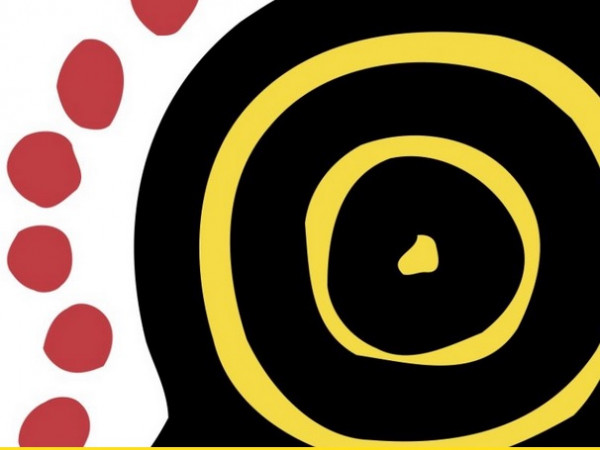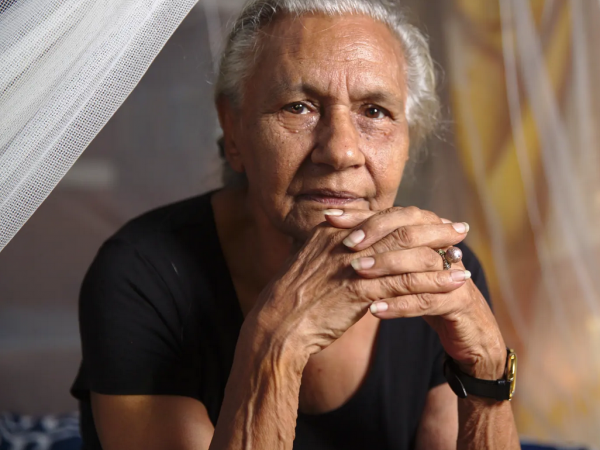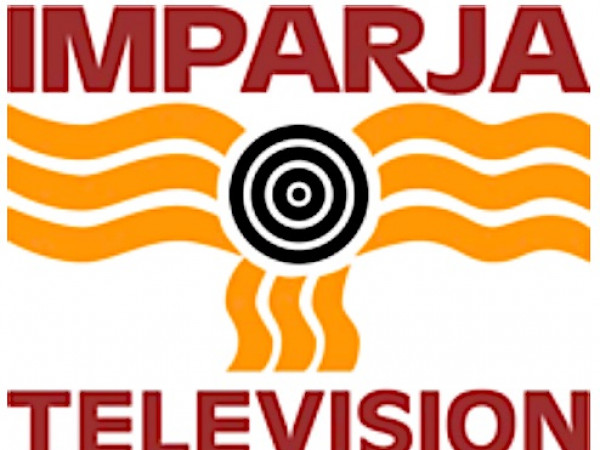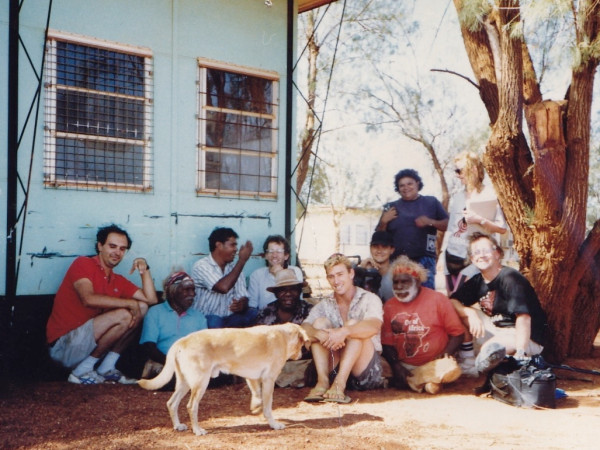Cilla Atkins
“We’ve gone up to the next level now…”
Satellite Dreaming to me was such a special film, because it was really going back way back to how Aboriginal media started and how and you know, how it was started by Freda Glynn. And then you moved to doing Imparja Television and then just linking it to all the other remote communities, like at Ernabella and Yuendumu about how they started Aboriginal media. And it was just a fantastic opportunity to see how that growth of Aboriginal media developed, and it developed quite quickly over that time.
The sort of documentaries that I had been working on, at CAAMA at that time, were more language programmes and cultural programmes. So we're doing like Nganampa Anwernekenhe, where it was in 100 per cent language. Urrepeye was an Aboriginal current affair programme. So, this was really quite different where it was doing more of a documentary style, rather than doing language and culture.
I found it great fun, though, you know, especially went out to Ernabella and had to go out bush there and… film them doing the Seven Sisters Dreaming. I mean, all that stuff was really, really exciting, and it was just really interesting to see how, you know, non-Aboriginal filmmakers were filming out in those communities because, you know, we're about in the middle of Woop Woop, no electricity, no water, no nothing. And, you know, we're all really, you know, sensitive to that. So, you know, we know about preserving everything: you'd have, like Ivo, you know, like just wasting water and wasting things that…wearing white in the red dirt. And we're like, OK, you're very different…
I think I really loved it, especially when we went out to Yuendumu, you know, and working out there with Warlpiri Media and Francis Kelly and, you know, all the things that they had been doing in that time - and …just listening to, you know, even like the interviews with Freda and stuff, because, you know, we’ve worked with these people for years and years. But, you know, you never kind of sit down and go back in history and say, well, how did it actually start? You know, how did you actually do this? So, you know, for me, who'd been working in the media for a while, it was it was so interesting to see how they came about developing Aboriginal media back in that day.
That was really exciting because, you know, a lot of our mob, you know, a lot of that going out bush and just going through all those, them songs, especially that Seven Sisters Dreaming because the Seven Sisters Dreaming goes right across Australia, you know, and it was just exciting just to see them all coming together and realising that they hadn't sung that song for a long time or had been one of the lost songs. And it was just great to work with our countrymen out there.
I continued working at CAAMA and I started making…I was the series producer then for ABC and SBS, so I started making quite a few documentaries for them. And then I end up doing a documentary with David Suzuki with the Canadian Broadcasting Corporation. And then I made another film with …who else was it? We were doing quite a bit with Channel Nine and Channel Seven. And then I used to fly overseas quite a bit and I ended up creating and producing a television drama for Disney.
Everything I did was with CAAMA, so they would just contract me. So, you know, so I'd be contacted by ABC and SBS to be a series producer, so they didn't pay me directly. They just did a contract straight with CAAMA.
I continued working for CAAMA for about 20 years, and then moved up to Darwin in 2007 and moved into the legal industry.
So at that time, this is going back, oh, just before I left, maybe around the 2005 - the Commonwealth Government put out a feasibility study into the establishment of an indigenous television station. And so Owen Cole, Rachel Perkins and myself sat down: we thought, well, why don't we just give this a shot? You know, why don't we just actually put in an application? So, then we brought in people like John Corker, who was a lawyer, and just other people who had a bit more expertise in, more on the legal side of it. And we put in an application to the Commonwealth Government - and then they actually gave us $48 million. So by then we thought ‘oh, this is a bit real! So we actually have to do this now…’ So, it was interesting because we then employed Pat Turner as an interim CEO and set up like an interim board. So, then we had to develop the Constitution. But the biggest thing was how were we going to broadcast it? You know, so that's we were approaching SBS and ABC to see if we could get their second line, so that we could broadcast it nationally from there. And then it was also about content. You know, we now have to have 24 hours of content. Where are we going to get that from? And in the meantime, not only are we buying in the content, but we have to make the content. So, it's about setting up all of those structures and then about where the office would be, you know, where would the television station be. And, you know, should we have it in Alice Springs where that's where the culture is, or should we have it in Sydney where the big media is? So, it was all of that and it was just it was just good fun doing it.
I mean, if you work in any sort of Aboriginal industry is always going to be difficult, you know, but at the end of the day we’re so used to it. So to me, it's not too difficult, you know, because we do this every day. But it was a bit of a clash with ICTV and NITV, because ICTV wanted to run, you know, two, three hour programmes. And we're like, well, you can't do that on a television station because you've got set time frames. So, you know, that's where the agreement had come from, was that ‘ICTV you still continue.. because you can play you know, you can play a traditional dance or song or whatever for …hours’. And, NITV would be more of a, more structured like a normal national television.
Well, I think since Satellite Dreaming I mean, really, Aboriginal media just boomed, you know, and I’ve seen that boom come from CAAMA. It was all the, all the mob that we grew up with and worked with at CAAMA that call it then went out, you know, down to Sydney and Melbourne and Perth. And they started then just spreading their wings and just, you know, Aboriginal media just grew. So, you know, we went from making, you know, language programmes for Imparja Television to making, you know, documentaries for overseas networks. And then it was making television drama for commercial networks like Disney …and Channel Nine. And then we were you know, our films were travelling around the world actually, winning huge awards as well as, you know, winning a lot of the Australian Film Awards as well. And then from there, you know, is where we developed to own Aboriginal television station, which was a national network, which was on top of Imparja. So… that was over a short period of time. And it was just, it was because we were so eager to have Aboriginal media out there and just showing everyone, you know, not only about our language and culture, but just how funny Aboriginal people can be and, you know, all the different things that we can do that we just really wanted to showcase, and we wanted to showcase it through media.
I think indigenous media is in a good place at the moment. You know, not only do we have our own national television station and our own Imparja television station - a commercial television station - but a lot of our filmmakers are making, you know, huge feature films. You know, we've gone up to the next level now. You know, we've done the short films, we've done the documentaries, we've done the television dramas. And now we're actually doing feature films with, you know, well recognised actors in it. So, you know, it's … a great place to be. And I can see it just growing even further.
So, not only do I manage the legal service in the whole of the Northern Territory and also chair all the Aboriginal legal services around Australia, it's also working with all the other key Aboriginal peak bodies and developing strategic plans on how we're going to make this significant change to improve lives of Aboriginal people. And that's right across everything. You've got justice, housing, education, mental health, everything. And it's a different way we're doing it now. We actually have regular meetings with Aboriginal organisations, Commonwealth agencies and territory and state government agencies as well, and Ministers. So, we're all working together and not in a tokenistic way, in a real way to make that difference.
I think times have really changed, you know, and I think the politicians have recognised that, that they can't just go ahead and try and fix all Aboriginal issues without working with Aboriginal people. So, they've really changed the working relationship, so that we've got Closing the Gap you know, which looks at all those priority areas: your justice, your health, … education, your housing, but they're not doing it on their own. What they've now done is form the Coalition of Peaks. So they're working with all Aboriginal industries on making those decisions on how to make a change. So, now things have really changed where you don't have governments just, you know, full bore ahead doing their own thing. They're actually stepping back and working with us to make that change. So I'm actually hopeful for a change.




